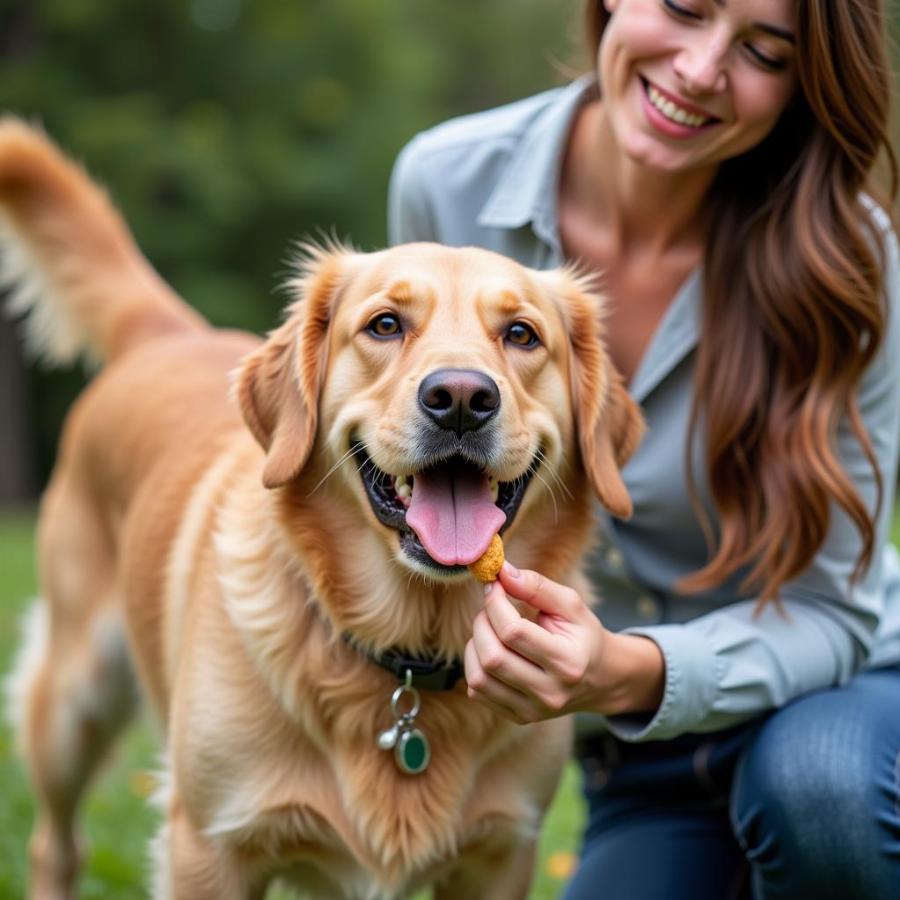Taming a dog, especially a rescue or a dog new to your home, can seem daunting. But with patience, understanding, and a structured approach, you can build a trusting and loving bond with your furry friend. This guide will provide you with proven techniques and expert advice on how to tame a dog, transforming them into a well-adjusted and happy member of your family.
Understanding the Taming Process
Before diving into the how-to’s, it’s crucial to grasp what taming a dog truly means. It’s not about “breaking” a dog’s spirit or forcing submission. Instead, it’s about building a foundation of trust and communication based on positive reinforcement.
Think of it as earning your dog’s trust and respect through consistent kindness, clear boundaries, and rewarding good behavior.
Building a Foundation of Trust
1. Patience is Key
Taming a dog is a journey, not a race. Some dogs warm up quickly, while others may take weeks or even months to fully adjust. Avoid rushing the process, and instead, allow your dog to acclimate to their new environment at their own pace.
2. Create a Safe Space
Provide your dog with a designated safe space where they can retreat to when feeling overwhelmed or anxious. This could be their crate, a dog bed, or even a quiet corner of a room. Respect their need for solitude, especially in the initial stages of the taming process.
3. Positive Reinforcement is Your Superpower
Positive reinforcement is the cornerstone of successful dog training and taming. Reward desired behaviors, such as approaching you calmly, following simple commands, or allowing you to pet them, with treats, praise, or a favorite toy.
 Dog Receiving Treats During Training
Dog Receiving Treats During Training
Establishing Clear Communication
4. Body Language Speaks Volumes
Dogs are masters of non-verbal communication. Learn to interpret their body language to understand their emotions and anticipate their reactions. A wagging tail doesn’t always signify friendliness, and a lowered head doesn’t always mean submission.
5. Start with Basic Commands
Teaching basic commands such as “sit,” “stay,” “come,” and “down” provides your dog with a framework for understanding expectations and boundaries. Use positive reinforcement techniques to make learning enjoyable and rewarding.
6. Leash Training for Control and Confidence
Leash training is not just about teaching your dog to walk politely on a leash. It’s also an excellent tool for building confidence and trust. A well-fitted harness and leash provide a sense of security and control, especially in new or stimulating environments.
Addressing Common Challenges
7. Dealing with Fear and Anxiety
Many dogs, especially rescues, may exhibit signs of fear or anxiety. Avoid forcing interactions and instead, allow them to approach you on their own terms. Use high-value treats, gentle praise, and patience to help them build positive associations with you.
8. Managing Reactivity
If your dog displays reactivity towards other dogs or people, seek professional help from a certified dog trainer or behaviorist. They can assess the situation and provide tailored guidance on behavior modification techniques.
Tamed to Trained: Continuing the Journey
Remember, taming is just the first step in a lifelong journey of learning and companionship. Once your dog has settled in and built a foundation of trust, you can further enrich their lives through:
- Continued training: Enroll in obedience classes, explore dog sports, or teach fun tricks.
- Socialization: Gradually introduce your dog to new environments, people, and well-mannered dogs.
- Enrichment: Provide plenty of mental and physical stimulation through puzzle toys, interactive feeders, and regular walks or playtime.
Conclusion
Taming a dog is a rewarding experience that strengthens the bond between you and your canine companion. By approaching the process with patience, understanding, and a commitment to positive reinforcement, you can help your dog thrive in their new home and enjoy a lifetime of love and companionship. Remember, the journey might have its challenges, but the rewards of a tamed and well-adjusted dog are immeasurable.
FAQs
1. How long does it take to tame a dog?
There’s no one-size-fits-all answer, as each dog is unique. It can take anywhere from a few weeks to several months depending on the dog’s history, personality, and your consistency in applying the techniques.
2. Can you tame an older dog?
Absolutely! While it might take a bit more patience and understanding, older dogs can learn and adapt to new environments.
3. What if I’m struggling to tame my dog?
Don’t hesitate to seek professional help from a certified dog trainer or behaviorist. They can provide personalized guidance and support tailored to your dog’s specific needs.
Still, have questions about taming your furry friend?
Check out these other helpful articles:
Beaut Dogs is your trusted source for all things dog-related. For expert advice and support on taming your dog, contact us at [email protected]. We’re here to help you build a happy and fulfilling life with your beloved canine companion.